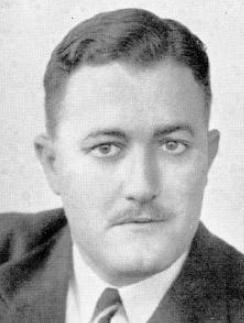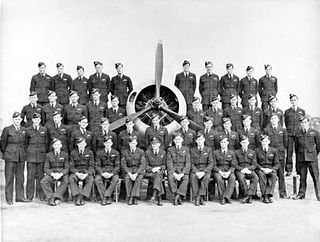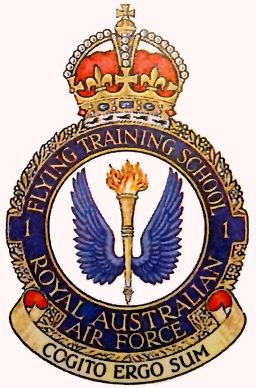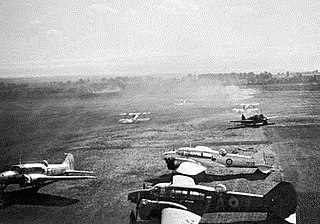
The British Commonwealth Air Training Plan (BCATP), or Empire Air Training Scheme (EATS) often referred to as simply "The Plan", was a massive, joint military aircrew training program created by the United Kingdom, Canada, Australia and New Zealand, during the Second World War. BCATP remains one of the single largest aviation training programs in history and was responsible for training nearly half the pilots, navigators, bomb aimers, air gunners, wireless operators and flight engineers who served with the Royal Air Force (RAF), Royal Navy Fleet Air Arm (FAA), Royal Australian Air Force (RAAF), Royal Canadian Air Force (RCAF) and Royal New Zealand Air Force (RNZAF) during the war.

Woomera, unofficially Woomera village, refers to the domestic area of RAAF Base Woomera. Woomera village has always been a Defence-owned and operated facility. The village is located on the traditional lands of the Kokatha people in the Far North region of South Australia, but is on Commonwealth-owned land and within the area designated as the 'Woomera Prohibited Area' (WPA). The village is approximately 446 kilometres (277 mi) north of Adelaide. In common usage, "Woomera" refers to the wider RAAF Woomera Range Complex (WRC), a large Australian Defence Force aerospace and systems testing range covering an area of approximately 122,000 square kilometres (47,000 sq mi) and is operated by the Royal Australian Air Force.
RAAF Base Woomera (WMA), was proclaimed by Chief of Air Force Directive in January 2015. RAAF Base Woomera and the RAAF Woomera Test Range (WTR) are the two formations which make up the RAAF Woomera Range Complex (WRC). RAAF Base Woomera consists of two sectors, 'Base Sector North' which is a restricted access area and includes Camp Rapier. the entrance to the Woomera Test Range and the RAAF Woomera Airfield. 'Base Sector South' is accessible by the public and essentially encompasses that part of RAAF Base Woomera long referred to as the Woomera Village. Woomera Village is often quoted as a 'remote town'. It is not a 'town', but rather an 'open base' of the RAAF. The 'village' has previously always functioned as an Australian Government/Defence Force garrison facility until it was fully incorporated into RAAF Base Woomera in 2015.

No. 2 Flying Training School is the main flying training school of the Royal Australian Air Force (RAAF). Formed under its present name in 1969, it is located at RAAF Base Pearce, Western Australia. The unit operates a fleet of Pilatus PC-21 turboprop trainers. No. 2 FTS traces its origins to the post-war re-establishment of the Air Force's original cadet training unit, No. 1 Flying Training School, at RAAF Point Cook, Victoria, in 1947. Following reorganisation of aircrew training in 1951–52, No. 1 FTS was renamed No. 1 Applied Flying Training School, and began specialising in advanced flight instruction on CAC Wirraways. It relocated to RAAF Base Pearce in 1958, where it converted to De Havilland Vampire jet trainers. In January 1969, the school was reformed as No. 2 FTS, having the previous year begun replacing the Vampires with Macchi MB-326Hs. The Macchis were themselves replaced by the PC-9 beginning in 1989.

RAAF Base Rathmines is a heritage-listed former RAAF Second World War seaplane base and now used as community venues, sports venues and a visitor attraction at Dorrington Road, Rathmines, City of Lake Macquarie, New South Wales, Australia. It was in use as an RAAF base from 1939 to 1961. It is also known as Rathmines Park, former RAAF Seaplane Base, Flying Boat Base, Rathmines Aerodrome and Catalina Base. The property is owned by Australian Christadelphian Bible School, Disability Life Enrichment, Don Geddes Nursing Home and Lake Macquarie City Council. The remains of the former air base was added to the New South Wales State Heritage Register on 25 November 2005.

No. 60 Squadron was a Royal Australian Air Force fighter squadron of World War II. It was formed in January 1942 and disbanded three months later, without seeing combat.

No. 20 Squadron is a Royal Australian Air Force (RAAF) support squadron. Coming under the control of No. 96 Wing, it is responsible for the management of the airfield at RAAF Base Woomera, South Australia. The squadron originated as a maritime patrol unit during World War II. Raised in August 1941, it operated PBY Catalina and Short Empire flying boats from bases in New Guinea, Queensland and the Northern Territory, conducting search-and-rescue, mine-laying, anti-submarine and bombing missions against Japanese targets in the Pacific theatre. Following the conclusion of hostilities, the squadron was disbanded in March 1946. It was reactivated as an airfield support squadron in April 2015.

Uranquinty is a small town approximately 15 kilometres (9 mi) south of Wagga Wagga, in the Riverina region of New South Wales, Australia. The population of the town, often referred to as "Quinty", is 909.
RAAF Base Mallala was a Royal Australian Air Force (RAAF) base at Mallala, South Australia.

Bruce William Graham, OBE was an Australian politician. He was a member of the Liberal Party and served in the House of Representatives for over 20 years, representing the New South Wales seats of St George and North Sydney (1966–1980).

No. 5 Service Flying Training School was a Royal Australian Air Force (RAAF) flight training unit that operated during World War II. It was one of eight Service Flying Training Schools established by the RAAF to provide intermediate and advanced flying instruction to new pilots as part of Australia's contribution to the Empire Air Training Scheme. No. 5 SFTS was formed at RAAF Station Uranquinty, New South Wales, in October 1941, and disbanded in February 1946. Its staff and equipment were employed to re-establish No. 1 Flying Training School, which transferred to RAAF Station Point Cook, Victoria, the following year. Care and Maintenance Unit Uranquinty was also formed from No. 5 SFTS's facilities, to look after surplus aircraft at the base prior to their disposal, and disbanded in December 1948.

No. 1 Flying Training School is a school of the Royal Australian Air Force (RAAF). It is one of the Air Force's original units, dating back to the service's formation in 1921, when it was established at RAAF Point Cook, Victoria. By the early 1930s, the school comprised training, fighter, and seaplane components. It was re-formed several times in the ensuing years, initially as No. 1 Service Flying Training School in 1940, under the wartime Empire Air Training Scheme. After graduating nearly 3,000 pilots, No. 1 SFTS was disbanded in late 1944, when there was no further requirement to train Australian aircrew for service in Europe.

No. 7 Service Flying Training School was a flying training school of the Royal Australian Air Force (RAAF) during World War II. It was formed in June 1941, and commenced flying the following month. Responsible for intermediate and advanced instruction of pilots under the Empire Air Training Scheme (EATS), the school was based at RAAF Station Deniliquin, New South Wales, and operated CAC Wirraway single-engined trainers. The Wirraways were classed as reserve aircraft for Australia's defence in response to the outbreak of the Pacific War in December 1941. Having graduated over 2,000 pilots, the school was renamed the Advanced Flying and Refresher Unit (AFRU) in December 1944. AFRU was disbanded in May 1946.

No. 2 Service Flying Training School was a flying training school of the Royal Australian Air Force (RAAF) that operated during World War II. It was formed in July 1940, under the command of Wing Commander Frederick Scherger. Responsible for intermediate and advanced instruction of pilots under the Empire Air Training Scheme (EATS), the school was based at RAAF Station Forest Hill near Wagga Wagga, New South Wales, and operated CAC Wirraway and Avro Anson aircraft. The Ansons were phased out in July 1941, and the school became an all-Wirraway unit. In 1942 the RAAF divided the personnel and equipment of No. 2 SFTS between Nos. 5 and 7 Service Flying Training Schools at Uranquinty and Deniliquin, respectively. No. 2 SFTS was disbanded that April, and the base facilities taken over by No. 5 Aircraft Depot.

No. 1 Basic Flying Training School was a flying training school of the Royal Australian Air Force (RAAF). Along with No. 1 Initial Flying Training School, it was formed in response to increased demand for aircrew during the Korean War and Malayan Emergency. No. 1 BFTS was established in December 1951 at RAAF Base Uranquinty, New South Wales, where it operated de Havilland Tiger Moths and CAC Wirraways. The school absorbed the activities of No. 1 IFTS in January 1955, as aircrew training requirements had eased following the end of the Korean War. No. 1 BFTS moved to RAAF Base Point Cook, Victoria, in May 1958, by which time it was exclusively flying CAC Winjeels. Its training program expanded in the mid-1960s owing to Australia's commitments in the Vietnam War. No. 1 BFTS was re-formed as No. 1 Flying Training School at Point Cook in January 1969.

No. 1 Initial Flying Training School was a flying training school of the Royal Australian Air Force (RAAF). It was formed in 1951 as No. 1 Initial Training School, in response to increased demand for aircrew during the Korean War and Malayan Emergency. Headquartered at RAAF Station Archerfield, Queensland, and operating de Havilland Tiger Moths, the unit was renamed No. 1 Initial Flying Training School in 1952. Ground staff from the school won the Hewitt Trophy for small arms proficiency in 1953. Aircrew training requirements eased following the end of the Korean War, and No. IFTS merged with No. 1 Basic Flying Training School at RAAF Base Uranquinty, New South Wales, in 1955.
The Royal Australian Air Force College is the Royal Australian Air Force training and education academy which is responsible for all the Air Force's initial, career development, promotion and leadership training. The RAAF College is headquartered at RAAF Base Wagga, 10 km (6 mi) east of the city of Wagga Wagga, New South Wales.

No. 2 Elementary Flying Training School was a Royal Australian Air Force (RAAF) pilot training unit that operated during World War II. It was one of twelve elementary flying training schools employed by the RAAF to provide introductory flight instruction to new pilots as part of Australia's contribution to the Empire Air Training Scheme. No. 2 EFTS was established in November 1939 as No. 3 Flying Training School at Archerfield, Queensland, and partially utilised aircraft and facilities of the civilian air training organisations based there. The school was renamed No. 2 EFTS in January 1940. It was disbanded in March 1942, and its operations transferred to No. 5 Elementary Flying School at Narromine, New South Wales, and No. 11 Elementary Flying School at Benalla, Victoria.
















